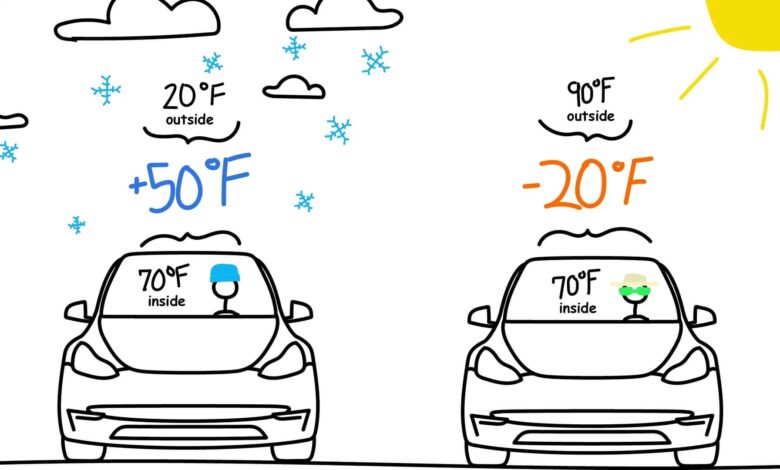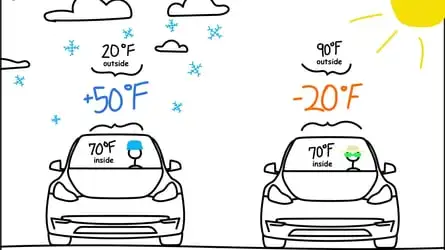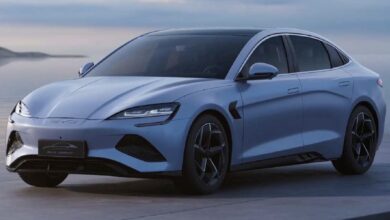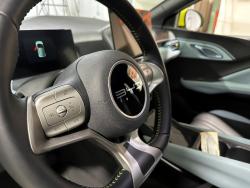Here’s How Hot Weather Affects Electric Car Range

Everybody knows cold weather has a big impact on the driving range of electric cars, but what about when it’s scorching hot?

A new study from Recurrent, which analyzed battery readings from 7,500 electric vehicles, found that electric vehicles can lose as much as 31% of their advertised range in sweltering weather.
That’s because getting a sweltering cabin to cool down when it’s 100 degrees outside can take a lot of energy out of the high-voltage battery. But even so, there are ways to alleviate the problem, and–more importantly–it’s good to know that range loss in the summer is much less pronounced than in the freezing winter.
Tips for getting the most range in the summer
When it’s very hot outside, try to park in the shade if possible. If you don’t have access to a garage or a covered parking space, you can use sunshades to shield the interior from the heat. Additionally, if you have a home charger, it’s recommended that you keep the car plugged in while pre-cooling the cabin. You should also avoid leaving an EV in the sun with a low state of charge.
According to Recurrent’s data, as the temperature goes up, so does the potential range loss, as more energy needs to be used to cool down the scorching interior. Depending on the ambient temperature, here’s what you can expect:
- At 75F (24C): 0% range loss;
- At 80F (27C): 2.8% range loss;
- At 85F (29C): 3.5% range loss;
- At 90F (32C): 5% range loss;
- At 95F (35C): 15% range loss;
- At 100F (38C): 31% range loss.
The higher the difference between the ambient temperature and the climate control temperature, the more energy will be used, leading to a higher range loss compared to the advertised figure.
Just like in the winter, the best solution to avoid range loss is to keep the car plugged into your home charger and pre-cool the interior before setting off. This way, the cabin gets nice and cool and doesn’t use energy from the battery; instead, it takes it from the mains.
According to Recurrent, the A/C system in a modern EV can use 3 to 5 kilowatts of power for the initial cooldown, and then the power usage settles around 1 kW to maintain the set temperature.
Chevrolet Bolt EV/Bolt EUV
The analytics company shared several graphs showing how individual EVs are affected by the hot weather. The discontinued Chevrolet Bolt EV’s real-world range is most affected at 60 and 95 degrees Fahrenheit, where it can lose roughly 5% to 8% of its advertised range. At the same time, however, the real-world range when it’s 80 degrees outside can surpass the official range rating by about 5%, according to data pulled from 13 vehicles enrolled in the Recurrent platform.
The Hyundai Kona Electric outperformed its estimated EPA range in all warm weather conditions, offering between 122% and 130% of its advertised range when driving between 60 to 95 degrees Fahrenheit ambient temperatures.
The Ford Mustang Mach-E, on the other hand, only outperformed its EPA range between 80 and 95 degrees, while driving at 60 degrees Fahrenheit resulted in a drop of roughly 7% in real-world range, according to data pulled from 20 vehicles.
A Tesla Model S charging from a home charger
When it comes to Tesla EVs, they offer the most consistent range readings no matter how hot it is outside. However, according to Recurrent, they only offer roughly 60% of their advertised range numbers in real-world conditions, so take that as you may.
The minimal range losses due to hot weather are due to the highly efficient heat pump that handles both cooling and heating for new Tesla models. Recurrent said that a Tesla EV—be it the Model 3, Model Y, Model S, or Model X—can use as little as 1 kW or as much as 6 kW to cool the cabin, but on average, that figure is between 1 and 3 kW.
What’s your take on this? Have you experienced range loss during very hot summer days? Let us know in the comments below.
Read more



